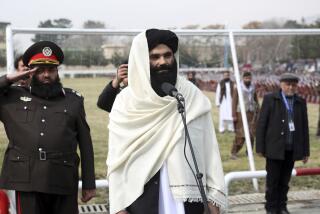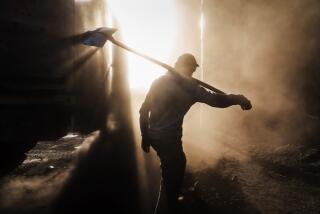Behind Afghanistan’s rising attacks, 3 men
- Share via
WASHINGTON — The escalating insurgency in Afghanistan is being spearheaded by a trio of warlords who came to prominence in the CIA-backed war to oust the Soviets but who now direct attacks against U.S. forces from havens in Pakistan, according to U.S. military and intelligence officials.
Militant groups led by the three veteran mujahedin are behind a sharp increase this year in the number and sophistication of attacks in Afghanistan and pose a major challenge to President Bush’s hope of stabilizing the country by deploying thousands of additional troops.
Despite a flurry of U.S. airstrikes against their organizations and million-dollar bounties on their heads, the Pashtun chieftains have been able to operate, and even expand their networks, largely unmolested from bases spread along the border with Pakistan.
U.S. intelligence officials have lamented the difficulty of tracking down Al Qaeda leader Osama bin Laden. But the hunt for the three warlords has in some ways been even more frustrating, in part because of their often high-profile roles in directing operations against U.S.-led military forces and other Western targets in Afghanistan.
Because of their battle experience and credentials, the warlords “play both an operational role and a psychological role,” said a senior Bush administration official involved in tracking the insurgency.
Citing their ability to attract recruits and orchestrate attacks, “it would be a mistake to underestimate the influence of any of them,” said the official, who, like others, discussed intelligence assessments about the warlords on condition of anonymity.
The three warlords are Mullah Mohammed Omar, the former leader of the Taliban government in Afghanistan; Gulbuddin Hekmatyar, an Islamic hard-liner who briefly served as prime minister in the 1990s before ordering his forces to bomb the Taliban-run capital; and Jalaluddin Haqqani, a onetime Taliban Cabinet minister whose tribal group has accounted for some of the most brazen attacks this year.
U.S. officials said there was little evidence of substantial collaboration among the three, though there are indications that despite their past differences, they communicate and occasionally share information and resources.
The warlords are generally not blamed for a surge of violence in Pakistan. Instead, they are seen as exporters of violence to Afghanistan.
All three have for years been the focus of U.S. intelligence-gathering efforts. But Washington’s pursuit has taken on added urgency as the warlords have expanded their influence in lawless regions of Pakistan that not only are bases for attacks across the border in Afghanistan but serve as sanctuary for Al Qaeda.
“Our government as a whole recognizes the dangers these people pose, and they are indeed targets,” a senior U.S. intelligence official said. “Their operations, and their cooperation with Al Qaeda, make them more than a local or regional threat.”
The official said that strikes by unmanned CIA Predator aircraft and other military operations have yielded “important successes against their organizations, their training compounds and the networks through which anti-coalition fighters are funneled into Afghanistan.”
But the ability of the tribal leaders to escape harm underscores the daunting task the United States faces as security in Afghanistan deteriorates.
The three warlords’ organizations are arrayed in an arc along Pakistan’s border with Afghanistan. Haqqani and Hekmatyar have directed attacks in and around the Afghan capital, Kabul, and helped revitalize the insurgency in eastern Afghanistan, where U.S. forces are concentrated. Omar’s influence is mainly in the Taliban heartland to the south, radiating outward from Kandahar.
“Because they don’t hang their hats in Afghanistan, we really have got no options in terms of going after them,” said Capt. Michael Erwin, an intelligence officer with a U.S. special operations forces group that served in Afghanistan in 2007. “If Americans can’t get a guy like Haqqani or Hekmatyar, it’s because they’re deep into the FATA,” Pakistan’s Federally Administered Tribal Areas.
U.S. officials blame Islamic extremists based in Pakistan for a 30% increase in attacks on U.S. forces in Afghanistan this year. They have responded by using more unilateral force, including specially equipped Predators, on suspected bases in Pakistan’s tribal areas.
The three warlords have long-standing ties to Pakistan’s powerful spy service, the Inter-Services Intelligence agency, which U.S. officials have accused of collaborating with insurgent groups and tipping them to American strikes. The ISI has “a desire to maintain their status as leaders,” said a senior U.S. military analyst, referring to the three chieftains, who represent one way for Pakistan to influence events in Afghanistan.
Despite their similar backgrounds, the three have clashed at times and competed to take responsibility for attacks. Hekmatyar was a Taliban enemy as it rose to power, and Haqqani formally allied himself with the movement only after it had seized power and offered him a Cabinet post. Haqqani was rumored this year to have circulated a letter criticizing Omar’s leadership.
Hekmatyar, who is based north of Peshawar in Pakistan, is the most mercurial of the three. As an engineering student at Kabul University in the 1970s, he was accused of throwing acid in the faces of women who did not wear a veil. He became one of the most effective mujahedin leaders in the war against the Soviets during the 1980s, leading a group that received millions in CIA funding.
The CIA and U.S. special operations teams, hoping to turn him again, have approached Hekmatyar in recent years through intermediaries, according to U.S. sources. Last year, he was also contacted by representatives of Afghan President Hamid Karzai. The talks went nowhere, according to Afghan news reports.
Paul Pillar, former deputy chief of the CIA’s counter-terrorism center, described Hekmatyar as a “very ambitious, very strong-willed, vicious sort of guy. Unless he were directly, physically put out of commission, he is going to continue to vie for power.”
Hekmatyar’s Hezb-i-Islami group was accused of an ambush in August near Kabul that killed 10 French paratroopers.
Haqqani’s group has been linked to brutal attacks over the last year, including strikes that killed seven at the Serena Hotel in Kabul and 54 at the Indian Embassy. The group is also believed to be responsible for a coordinated attack in August involving at least 10 suicide bombers at a large U.S. base, Camp Salerno, in the eastern province of Khowst, which injured three soldiers.
Haqqani, who is in his 70s, is believed to have ceded much operational control to his sons, including Sirajuddin Haqqani, 34.
Haqqani has long-standing ties to Bin Laden, and his clan operates a network of madrasas, or religious schools, and training bases in North and South Waziristan, near the border with Afghanistan. The Haqqani network is considered a prime force not only in the recruitment of young men from Pakistan’s tribal areas, but in funneling in fighters from Central Asia and Arab countries.
Mullah Omar, who is in his 40s and lost an eye fighting the Soviets, remains a much more mysterious figure. Whereas Haqqani and Hekmatyar have appeared in videos and news footage, Omar’s visage has been seen publicly only in a few grainy photographs.
U.S. officials said there were as many as 14 disparate groups taking part in the insurgency in Afghanistan. But Omar, believed to be based in Quetta, Pakistan, remains the spiritual leader of what U.S. officials often call the “Big T” Taliban, the core tribes displaced from power in Kabul in the 2001 U.S.-led invasion of Afghanistan.
U.S. officials said Omar’s location in a densely populated city put him out of reach of airstrikes. And his broad support among Pashtuns makes Pakistani authorities reluctant to target him and risk an eruption of violence in their country.
To some who were involved in the CIA campaigns of the 1980s, the U.S. effort to beat back an insurgency led by Hekmatyar, Omar and Haqqani represents something of a role reversal.
“We’re trying to fend off security challenges to the government of Afghanistan from a collection of loosely allied groups chiefly of the militant Islamist variety,” Pillar said. In that sense, he said, “we have assumed the place of the Soviets.”
--
Times staff writer Laura King in Peshawar, Pakistan, contributed to this report.
More to Read
Sign up for Essential California
The most important California stories and recommendations in your inbox every morning.
You may occasionally receive promotional content from the Los Angeles Times.










